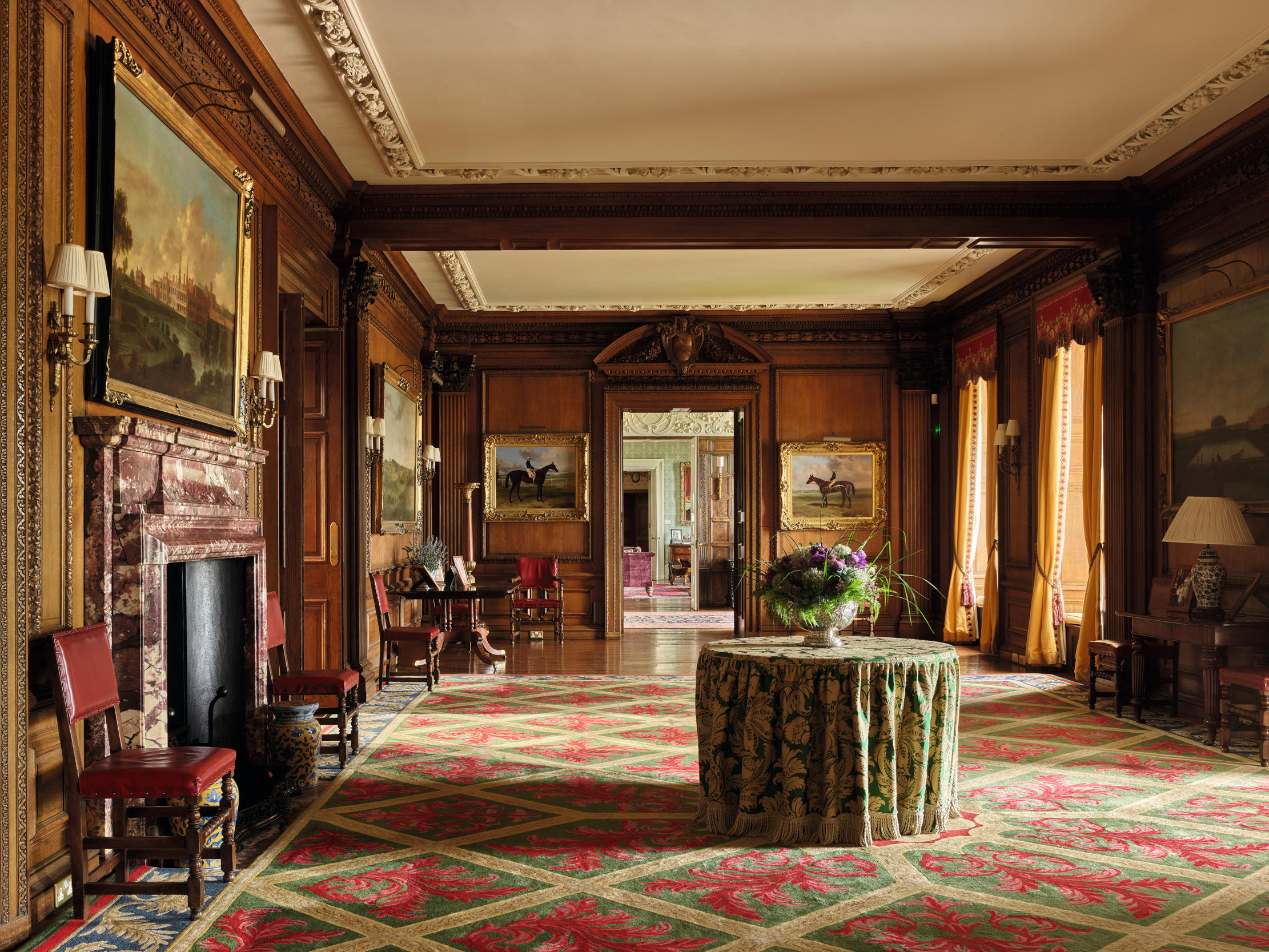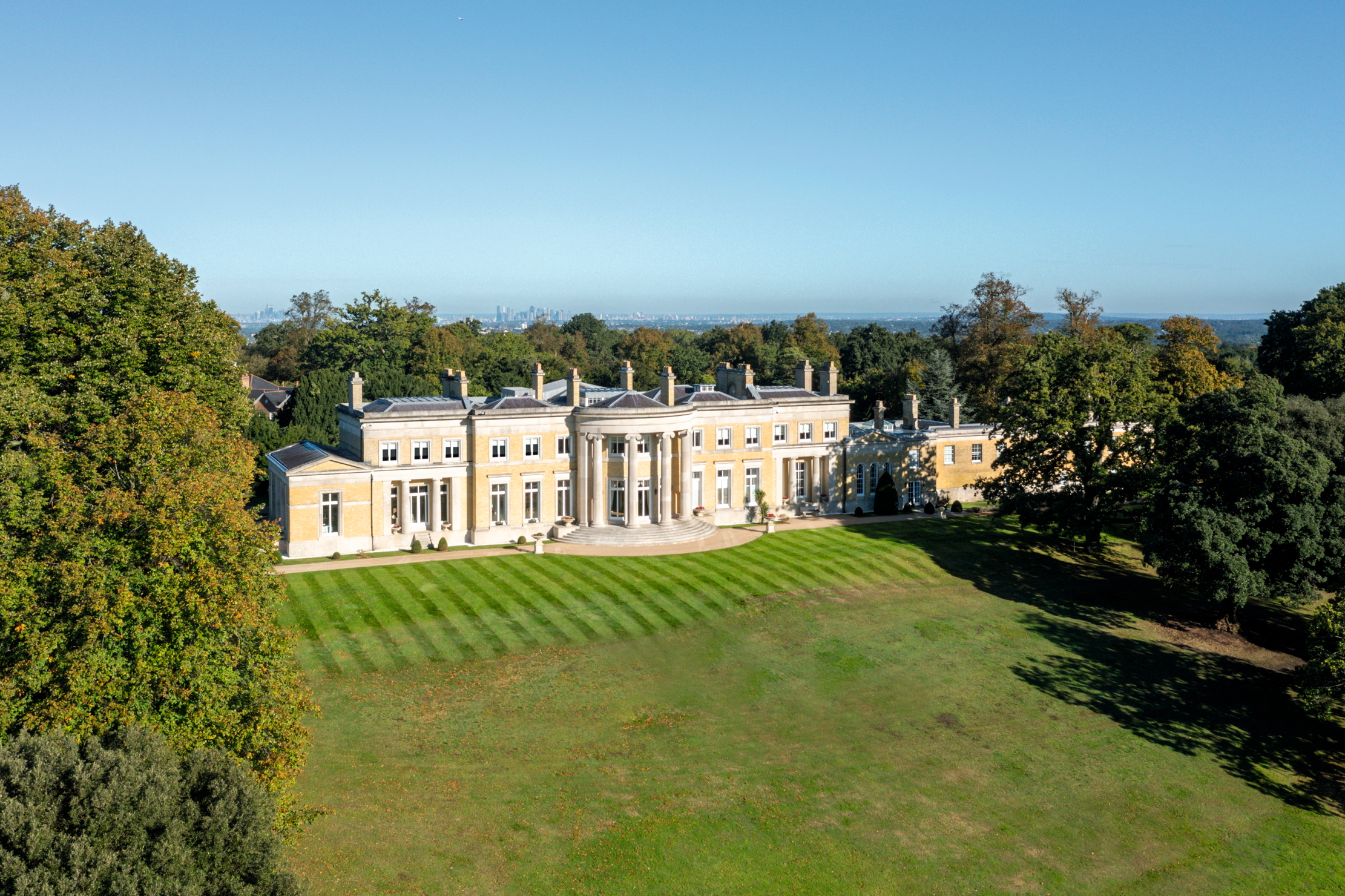Knowsley Hall: How Liverpool's grandest country house — and one of the largest homes in England — was brought back to life
Knowsley Hall in Merseyside was returned from institutional use in the 1990s to become the seat of the Earl and Countess of Derby. John Martin Robinson reports on progress to one of the most ambitious restorations of an English country house.


It is 25 years since the architectural history of Knowsley Hall was first unravelled in three articles in Country Life, published in the spring and summer of 1999. They marked the resuscitation of the house after the Earl and Countess of Derby took it back following a long institutional lease to the regional police force.
Since that time, a considerable amount more has been achieved. Continuing structural renovation has included the renewal of most of the sash windows in the west and north fronts and the 20 skylights over the State Dining Room. The restoration of the terrace gardens to the east and south has been carried out, with new borders and planting (Fig 5), as well as the re-landscaping of the forecourt with formal yew topiary (Fig 1).
Inside, the decoration and furnishing has continued with the revival of bedrooms and new bathrooms on the upper floors (used as utilitarian offices by the police) and new curtains, rugs and upholstery in the principal rooms.

The collection has gradually been catalogued, conserved, re-displayed and enhanced with new acquisitions and many discoveries. Paintings have been cleaned, a collection of 500 Roman imperial coins re-housed, the unique assemblage of 5,600 natural-history watercolours — including 200 by Edward Lear — formed by the 13th Earl, founder of the Knowsley Menagerie and Aviary (perpetuated today by the wildlife park that is visited by half a million people a year) has been digitised. It is an inspiring story recorded in this new article that draws attention to the more recent works at this, the major surviving family house of North-West England.
It has belonged to the Stanleys since 1385 and remains one of the largest Georgian houses in the country. As well as being used by the family and charities (Lord Derby is involved in 100 organisations in the region), it has become a successful venue for corporate events and weddings and has also hosted several scholarly conferences, including ‘Art, Animals and Politics’ in 2013, at which Sir David Attenborough was a key speaker, and, more recently, Shakespearean studies in association with the reconstruction of the late-16th-century playhouse in nearby Prescot, a northern Globe theatre.
Knowsley was one of 15 great houses chosen for their cultural, dynastic and political interest by Randolph Churchill in his Famous English Homes, published 70 years ago in 1954. Others included Hatfield in Hertfordshire, Wilton in Wiltshire, Chatsworth in Derbyshire, Holkham in Norfolk, Arundel in West Sussex, Alnwick in Northumberland, Althorp in Northamptonshire and Naworth Castle in Cumbria. Not only have they all survived, but all have witnessed exceptionally impressive programmes of renewal in the late 20th and 21st centuries.

The modern revival of the country house can be seen in retrospect to have been assisted by several key developments. The 1967 Civic Amenities Act, passed by Harold Wilson’s Labour government, provided strong legal protection by introducing listed-building consent for alterations and demolition of such places. That instantly stopped the destruction of historic buildings and demolitions dwindled from thousands to nothing. The 1976 Finance Act that was passed by the Labour Chancellor Denis Healey enabled the creation of maintenance funds and charitable trusts specifically to maintain historic buildings, which had not been possible hitherto. This provided a new legal framework soon adopted by many country houses.
Sign up for the Country Life Newsletter
Exquisite houses, the beauty of Nature, and how to get the most from your life, straight to your inbox.
Less direct were Margaret Thatcher’s economic reforms of the 1980s, which, although intended primarily to benefit industry, exports and the City’s international finance role, had an impact, too, on landed estates, making it easier to borrow money for capital projects (which had been impossible with entailed property) and promoted a business ethos. This encouraged the development of country houses and estates as commercial enterprises, not only day-visiting tourism, but letting for sport, leisure and corporate events, such as weddings and festivals, of which the Dukes of Richmond at Goodwood in West Sussex and Roger Tempest of Broughton Hall in North Yorkshire were trail-blazing exemplars.

The recent history of Knowsley can be seen in this context. The 19th Earl of Derby inherited from his uncle in 1994 and married Caroline Neville, a daughter of Lord Braybrooke, the following year. Together, they took back the hall after 30 years of institutional use, reinstating it as the historic family seat underpinned by a new business framework, including ‘corporates’ and filming, made possible by the location only eight miles from the centre of Liverpool. Within two years of taking back the house, it was transformed from neon-lit, demountable partitioned offices to its historic appearance, with family pictures and furniture reinstated in the main rooms.
The 1999 Country Life articles traced the complex architectural development of the house from its origins as a medieval hunting lodge to a great early-Georgian country house replacing the former principal family seat at Lathom, destroyed in the Civil War. (The inter relationship of Knowsley and Lathom will be explored next week.) Continuous Victorian aggrandisements created a sprawling behemoth that was pruned and remodelled across two major 20th-century schemes, by William Henry Romaine-Walker in 1908–13 and by Claud Phillimore in 1953–54; these were the largest new building programmes in a major English country house in the first half of the 20th century. The current programme, begun in 1998, was planned to return the house to its appearance in the 1950s. Since then, the work has continued with ongoing structural repairs, redecoration and the conservation, augmentation and study of the collections, the latter under the direction of Dr Stephen Lloyd from the Scottish National Portrait Gallery, whom Lord and Lady Derby appointed as curator of the Derby Collection.

The initial phase of revival concentrated on the state rooms and especially the State Dining Room (Fig 2) with the rehang there of the complete dynastic array of family portraits by Lady Derby with advice from Sir Oliver Millar, then director of the Royal Collection. New curtains for the room of heavy wool to a late-19th-century pattern from Watts of Westminster have subsequently been hung at the large windows. More recent activity has been in part focused on the bedrooms, starting in 2015 with the revival of the Royal Lodgings in the south wing. A suite of bedroom, dressing room and sitting room, on the site of the medieval lodgings known to have been occupied by Henry VII and James I, had been re-created in a neo-Adam manner by Romaine-Walker in anticipation of the extensive state visit to Lancashire by George V and Queen Mary in 1913. In 1954, the rooms were occupied by Queen Elizabeth II during her post-Coronation visit to the county. From the 1960s, these rooms had been lived in as a ‘grace and favour’ apartment for key staff, notably by Marie Mazenauer, the Swiss Lady’s Maid to Isobel, Lady Derby, wife of the 18th Earl, until Marie’s death in 2014.
The marble chimneypieces that had been removed to Claud Phillimore’s 1960s new house in the park were replaced in replica by Jamb. As refurbished, the rooms are hung with family portraits and engravings, including Victorian coloured prints of the Grand National at Aintree, which continues to be a notable event in the Knowsley diary. Some of the old furniture has been re-acquired, including a pair of ormolu-mounted 19th-century bookcases and a small marble bust of the 14th Earl dated 1858. They were among various items retrieved from local antique dealers that had been disposed of in ‘surplus contents’ sales in the 1960s. A rare scarlet ground, Chinese-style screen of about 1800, found in the basement, has also been conserved and displayed here. Other discoveries in lumber rooms and archive stores include a rare 1594 Stanley heraldic pedigree painted on board for the 5th Earl, which, after conservation, now hangs in the King’s Corridor leading to the Royal Lodgings.

Seven additional guest rooms upstairs in the main block have been retrieved and decorated using Oliver Steer, a local designer, and the in-house maintenance team, members of which are responsible for all ongoing works. The bedrooms form a fascinating range of Edwardian ‘period’ interiors incorporating plasterwork from moulds or fittings, such as chimneypieces, from demolished places around Liverpool, including Finch House, West Derby. These historicist interiors at Knowsley parallel turn-of-the-20th-century taste chiefly manifested in fashionable Mayfair houses. They also include a couple of ‘Jacobean’ interiors: the Boardroom (Fig 8), upstairs at the south end of the east range, and the Jacobean Room, off the entrance hall (Fig 4), which has recently been identified as a replica of the Globe Room in the Reindeer Inn, Banbury, Oxfordshire. The latter was dismantled in 1912 when moulds were taken of its Jacobean plasterwork. The original room has since been reinstated at the Reindeer, but at least half a dozen Edwardian replicas are known, including the Prime Minister’s Room in the Palace of Westminster.
Romaine-Walker’s Restoration-style Grand Staircase (Fig 3) was refurbished in 2012–15. The walls are hung with five large paintings, including the Return of the Israelites to the Promised Land painted on leather in Venice, Italy, by Jacques Courtois, ‘Il Borgognone’, in 1656. The works had been acquired by the 12th Earl originally for the State Dining Room but were re-sited by Romaine-Walker as wall decorations on the staircase. These were conserved by the Hamilton Kerr Institute in Cambridge and the Liverpool Conservation Centre in 2012–15. The furniture has been augmented with a handsome long-case clock by Winstanley of Ormskirk, one of several loans from the Old Grammar School there, including an oak book chest in the Jacobean Room.

The library, formerly the picture gallery, but fitted with new classical bookcases designed by Claud Phillimore in 1954, has also been transformed (Fig 7). The oak-boarded floor has been revealed and polished, new rugs laid and the four great paintings by (or after) Ribera, Rubens, Bosschaert and Bellotto from the 10th and 12th Earl’s collection were cleaned between 2019–2023, as were the oval marble reliefs of Roman emperors from the 12th Earl’s collection, hung here by Phillimore as part of his Georgian scheme in 1954. By serendipity, Phillimore’s pencil-and-wash design for the bookcases was found in the old stationery cupboard and was conserved and hung here in 2021. Two late 19th-century marble busts of Milton and Shakespeare, hinting at the Derby patronage of the ‘Great Bard’ by the 5th Earl and his Countess, Alice, have been recently acquired and now flank Romaine-Walker’s heroic shrine/chimneypiece where the portrait of the Royalist ‘Martyr Earl’ (beheaded at Bolton in 1651) by Cornelius Johnson has been cleaned.
The same upgrading of textiles and conserving paintings extends into the adjoining Stucco and Walnut Drawing Rooms. In the former, the Zucchis of Adam’s pavilion for the 1774 marriage fête champêtre at Epsom of the 12th Earl were cleaned in 2023, as was the circular 1895 ceiling painting of Aurora by Gressington, a London theatre artist.

In the Walnut Drawing Room (Fig 6), the seat furniture has been upgraded with richer upholstery and the portraits cleaned. The art conservation programme has produced an unexpected bonus in the dazzling full-length portrait of Elizabeth Farren, the comic actress second wife of the 12th Earl. It was once thought to be an 1829 copy of the original (the former property of the Earl of Wilton and now in the Metropolitan Museum in New York), but has been re-attributed to Sir Thomas Lawrence himself, albeit with some studio assistance.
Knowsley as it appears today is a remarkable demonstration of how houses can be brought back to life, as well as how a historic collection that, despite the sale of paintings in the 20th century, is still extensive, can thrive and benefit from a major conservation programme, renewed display, cataloguing and study by contemporary scholars. The whole place has benefited from one of the most extensive recent historical restorations of an English country house.
Visit www.knowsleyhallvenue.co.uk

The house of a great Victorian adventurer who married Britain's richest heiress, won the Derby and became prime minister
When he wasn't living an extraordinary life that involved politics, sport and marrying into the Rothschild millions, Archibald Primrose put
-
 Seven of the UK’s best Arts and Crafts buildings — and you can stay in all of them
Seven of the UK’s best Arts and Crafts buildings — and you can stay in all of themThe Arts and Crafts movement was an international design trend with roots in the UK — and lots of buildings built and decorated in the style have since been turned into hotels.
By Ben West
-
 A Grecian masterpiece that might be one of the nation's finest homes comes up for sale in Kent
A Grecian masterpiece that might be one of the nation's finest homes comes up for sale in KentGrade I-listed Holwood House sits in 40 acres of private parkland just 15 miles from central London. It is spectacular.
By Penny Churchill